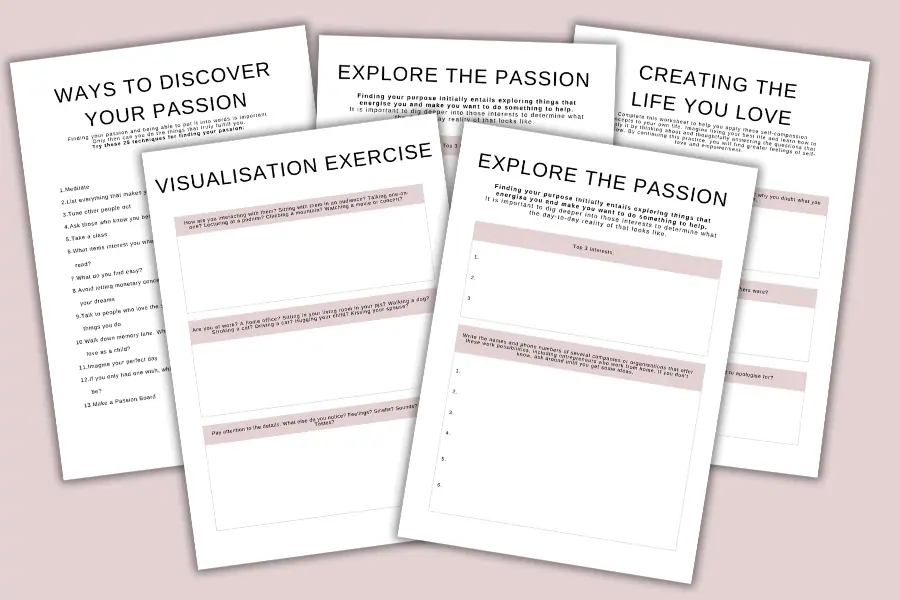How To Set Goals For Yourself

Setting goals is like charting a course for your life’s journey. It provides the roadmap that guides you towards your dreams and aspirations. It’s not just a mere exercise in wishful thinking; it’s a powerful tool that can transform your life in profound ways.
In this blog post, we’ll explore the art and science of how to set goals for yourself. You’ll discover how this simple practice can lead to extraordinary personal growth and achievement. Whether you’re striving for a career milestone, aiming for a healthier lifestyle, or pursuing a passion project, learning how to set goals for yourself is the first step towards turning your dreams into reality.
This blog post is about how to set set goals for yourself

Embarking on a Journey of Personal Growth
Goal setting is the compass that points you in the direction of personal growth. It challenges you to identify your strengths, confront your weaknesses, and reach beyond your comfort zone. With each goal you set, you’re inviting growth and transformation into your life.
Achieving beyond your wildest dreams
Goals aren’t just about reaching a destination; they’re about becoming the person you’ve always wanted to be. They empower you to tap into your full potential, to rise above obstacles, and to achieve feats you might have once thought impossible. They serve as milestones of your progress, reminding you of how far you’ve come and inspiring you to reach even higher.
As we delve deeper into this journey of self-discovery and achievement, you’ll learn practical strategies and timeless principles for setting goals that are not only attainable but also deeply meaningful to you.
Elevate your goal setting with the step by step guide Goal Tracker
Understanding the Importance of Goals
Setting goals isn’t just a task on your to-do list; it’s a cornerstone of personal development. It’s the force that propels you forward, urging you to become the best version of yourself. Let’s delve into why this practice is so crucial:
Fuel for personal growth
Goals serve as the fuel for personal growth. They act as catalysts, pushing you to step outside your comfort zone and embrace new challenges. When you set a goal, you’re essentially declaring your intent to evolve, to learn, and to adapt. This commitment to growth not only expands your skillset but also nurtures a mindset of continuous improvement.
Imagine a plant reaching towards the sun, yearning for light and nourishment. Goals serve as that vital sunlight, coaxing you to stretch towards your fullest potential. They provide the necessary nutrients for your personal development journey, propelling you towards heights you may not have even dreamed possible.
Providing direction and purpose
Life can often feel like a vast, uncharted sea. Without a compass, it’s easy to drift aimlessly, uncertain of where you’re headed. This is where goals come into play. They provide the much-needed direction, giving you a clear sense of where you’re going and what you’re striving to achieve.
Imagine you’re embarking on a road trip. You wouldn’t set out without a destination in mind, would you? Goals serve as your destination on the map of life. They give you a purpose to work towards, a target to aim for. They transform abstract desires into concrete objectives, guiding your actions and decisions with purposeful intent.
When you have a goal, you wake up each day with a sense of purpose and clarity. You know what you’re working towards, and every action becomes a deliberate step towards that destination. This sense of direction not only boosts your motivation but also infuses your life with a profound sense of meaning.
Types of Goals
Goals come in various shapes and sizes, each serving a specific purpose in your journey of personal development. Let’s explore the two primary categories: short-term and long-term goals.
Short-term goals
Short-term goals are like stepping stones on your path to success. They are objectives that you can achieve within a relatively brief timeframe, usually within days, weeks, or a few months. These goals offer immediate gratification and a sense of accomplishment. They help you build momentum and keep you motivated as you work towards your larger aspirations.
Examples of Short-term Goals:
- Completing a specific project at work by the end of the month.
- Exercising three times a week for the next two months to improve fitness levels.
- Saving a specific amount of money each week for a vacation fund.
Long-term goals
Long-term goals are the grand visions that shape the course of your life. They extend beyond immediate gratification and require sustained effort and commitment over an extended period. These goals serve as the North Star, providing a clear direction for your long-term aspirations and ambitions.
Examples of Long-term Goals:
- Obtaining a master’s degree in a chosen field within the next three years.
- Starting your own business and achieving financial independence within five years.
- Running a marathon or achieving a significant fitness milestone in the next year.
Differentiating between short-term and long-term goals allows you to create a balanced and realistic roadmap for your personal growth journey. Short-term goals provide the small wins that keep you motivated, while long-term goals give you a sense of purpose and a vision to work towards over time.
Remember, it’s important to align your short-term goals with your long-term objectives. This ensures that every small step you take is contributing to the larger, more significant milestones you’re aiming to achieve.
Identifying Your Goals
Setting meaningful goals starts with a deep dive into your own desires, values, and interests. It’s about aligning your aspirations with your authentic self, creating a path that resonates with who you truly are. Let’s explore how you can go about this process:
Reflecting on passions, interests, and values
Begin by taking a moment to reflect on what truly drives you. Consider the activities, subjects, or causes that light a fire within you. These are your passions, the things that you could talk about for hours on end without losing interest. Whether it’s painting, advocating for social justice, or immersing yourself in the world of literature, identifying your passions is the cornerstone of setting fulfilling goals.
Next, ponder on your interests. These are areas that captivate your curiosity and ignite a desire to learn more. They may not be as all-encompassing as your passions, but they still hold a special place in your heart. Whether it’s astronomy, sustainable living, or gourmet cooking, your interests provide a fertile ground for goal-setting.
Finally, consider your values. These are the guiding principles that define what truly matters to you in life. They shape your decisions, actions, and the way you interact with the world. Whether it’s integrity, compassion, or environmental stewardship, understanding your values helps you align your goals with your core beliefs.
Choosing goals in harmony with your personal vision
Once you’ve identified your passions, interests, and values, it’s time to translate them into tangible goals. Picture your ideal future, the life you dream of living. What achievements, experiences, and contributions are essential to this vision? These are the goals that resonate with your soul and drive you towards becoming the person you aspire to be.
For instance, if your passion lies in environmental conservation and your value is sustainability, a goal could be to lead a community initiative to reduce plastic waste. If you’re deeply interested in holistic wellness, a goal might be to complete a certification in holistic nutrition to help others lead healthier lives.
By aligning your goals with your personal vision, you’re not only setting yourself up for success, but you’re also crafting a journey that feels profoundly meaningful and fulfilling.
Set goals and smash them with this Goal Tracker. Did you know that you are 42% more likely to achieve your goals if you write them down!
Breaking Down Your Goals
Setting a big goal can be exhilarating, but it can also feel overwhelming. Breaking it down into smaller, manageable tasks not only makes it less daunting but also increases your chances of success. Let’s dive into how you can effectively break down and track your goals:
Breaking larger goals into smaller, manageable tasks
Imagine you’re planning a cross-country road trip. You wouldn’t try to cover the entire distance in a single day, right? Similarly, with goals, it’s crucial to break them down into bite-sized pieces.
Start by deconstructing your larger goal into smaller, specific tasks. Consider them as checkpoints on your journey. For example, if your goal is to write a book, your tasks might include brainstorming ideas, outlining chapters, and setting daily writing targets.
Assign realistic deadlines to each task. This helps create a sense of urgency and keeps you on track. It’s like setting milestones on the road to your ultimate destination.
Remember, the key is to make these tasks small and manageable. This not only makes the process less overwhelming but also allows you to experience a sense of accomplishment with each completed task.
Tips for tracking progress effectively
Tracking your progress is like having a map that shows you how far you’ve come and how much farther you have to go. Here are some tips to help you do it effectively:
Use a Goal Tracking Tool: There are numerous apps and tools available that can help you track your progress. Whether it’s a goal-setting app or a simple spreadsheet, find a system that works for you.
Set Milestone Check-Ins: Schedule regular check-in points to review your progress. This could be weekly, bi-weekly, or monthly. Reflect on what you’ve accomplished and adjust your approach if needed.
Celebrate Small Wins: Acknowledge and celebrate the completion of each task. It’s these small victories that keep you motivated and fuel your determination to move forward.
Stay Flexible: Sometimes, circumstances change, and you might need to adjust your timeline or approach. That’s perfectly okay. Being flexible allows you to adapt without losing sight of your ultimate goal.
By breaking down your goals and tracking your progress, you’re turning a distant dream into a tangible, achievable reality.
Maintaining Consistency
Consistency is the secret sauce that turns goals into achievements. It’s the steady rhythm of progress that propels you forward, even on days when motivation wavers. Let’s explore some essential tips for staying committed and the benefits of establishing routines:
Tips on staying committed and consistent
Set Clear Priorities: Prioritise your goals based on their importance and urgency. This helps you focus your time and energy on the tasks that will have the greatest impact on your progress.
Establish a Routine: Consistency thrives on routine. Set specific times or days for working on your goals. Whether it’s dedicating the first hour of your morning or setting aside a block of time every weekend, having a routine creates a structured framework for your efforts.
Use Reminders and Visual Aids: Utilise tools like calendars, task lists, or goal-tracking apps to keep your goals at the forefront of your mind. Visual cues serve as powerful reminders of your commitment.
Break Tasks into Daily Habits: Turn critical tasks into daily habits. For example, if your goal is to improve your fitness, commit to a daily walk or a short workout. These small, consistent actions accumulate over time.
Practice Self-Discipline: Cultivate self-discipline by setting clear boundaries and avoiding distractions. This might involve turning off notifications, creating a designated workspace, or setting specific work hours:
Benefits of establishing routines
Efficiency and Productivity: Routines eliminate decision fatigue and streamline your workflow. When you have set times for specific tasks, you can dive in without spending precious minutes deliberating on what to do next.
Reduced Stress and Anxiety: Knowing what to expect and having a clear plan in place can significantly reduce stress and anxiety levels. Routines provide a sense of stability and control, creating a more relaxed and focused mindset.
Improved Time Management: With a well-defined routine, you’re less likely to waste time on unproductive activities. This allows you to allocate your time efficiently towards your goals.
Creates Momentum: Routines provide a consistent rhythm to your efforts. They help build momentum, making it easier to transition into focused work on your goals.
Remember, consistency doesn’t mean perfection. It means showing up, day in and day out, and putting in the effort towards your goals. Over time, this steadfast dedication will yield remarkable results.
Setting Your Course
In this journey of discovering how to set goals for yourself, we’ve unraveled the power of this transformative practice. Let’s recap the key takeaways:
Understanding the Importance of Goals: Goals are not mere aspirations; they are the seeds of personal growth and purpose. They provide direction and serve as catalysts for self-improvement.
Types of Goals: Short-term goals offer quick wins and keep you motivated, while long-term goals paint the grand picture of your future, giving you a sense of purpose and direction.
Identifying Your Goals: By tuning into your passions, interests, and values, you align your aspirations with your authentic self, paving the way for meaningful and fulfilling goals.
Breaking Down Goals: Deconstructing larger goals into manageable tasks turns monumental challenges into achievable milestones. Setting realistic deadlines ensures you stay on course.
Maintaining Consistency: Consistency is the linchpin of progress. Establishing routines, setting priorities, and practicing self-discipline ensure you stay committed even when motivation wavers.
Now, it’s time for you to take action. The power to shape your future lies in your hands. Embrace this moment to start setting your own goals. Whether it’s a career ambition, a fitness milestone, or a creative pursuit, remember that every step counts.
Imagine the satisfaction of looking back at your journey, seeing how far you’ve come, and realising that you’ve turned your dreams into reality. It’s not about perfection; it’s about progress. Every effort, no matter how small, contributes to your personal growth and achievement.
So, seize this opportunity and embark on this transformative path. Set your goals, break them down, stay consistent, and watch as you inch closer to the life you envision. Your journey begins now.
This blog post was about how to set goals for yourself
Share this post: on Twitter on Facebook





